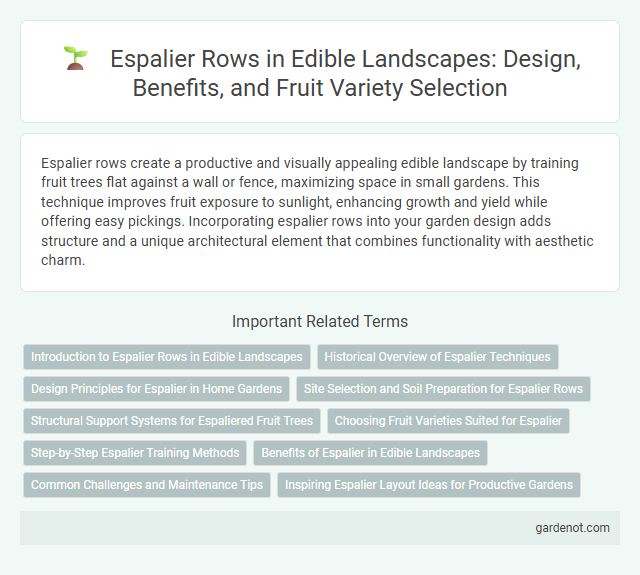Espalier rows create a productive and visually appealing edible landscape by training fruit trees flat against a wall or fence, maximizing space in small gardens. This technique improves fruit exposure to sunlight, enhancing growth and yield while offering easy pickings. Incorporating espalier rows into your garden design adds structure and a unique architectural element that combines functionality with aesthetic charm.
Introduction to Espalier Rows in Edible Landscapes
Espalier rows in edible landscapes maximize space by training fruit trees and vines against flat surfaces, enhancing both productivity and aesthetic appeal. This technique improves sunlight exposure, air circulation, and ease of harvest while creating structured, visually appealing garden features. Common species for espalier rows include apple, pear, and grape varieties, chosen for their adaptability and fruit quality.
Historical Overview of Espalier Techniques
Espalier techniques date back to ancient Egypt and Rome, where fruit trees were trained against walls to maximize space and improve fruit production. The practice gained prominence during the Middle Ages in Europe, combining horticultural skill with artistic design to create productive and decorative garden features. Espalier became integral in medieval and Renaissance orchards, reflecting both agricultural efficiency and aesthetic appeal in edible landscapes.
Design Principles for Espalier in Home Gardens
Espalier design in home gardens maximizes space by training fruit trees along flat, two-dimensional planes, enhancing both aesthetic appeal and fruit production. Key principles include selecting dwarf or semi-dwarf fruit varieties for manageable growth, ensuring strong structural support with sturdy wires or trellises, and maintaining consistent pruning to control shape and encourage fruiting spurs. Optimal sunlight exposure and air circulation are critical to prevent disease and promote healthy development in espalier rows.
Site Selection and Soil Preparation for Espalier Rows
Espalier rows require well-drained, fertile soil with a pH between 6.0 and 7.5 for optimal growth. Site selection should prioritize full sun exposure with good air circulation to reduce disease risk and enhance fruit production. Proper soil preparation includes deep tilling, incorporation of organic matter, and balanced fertilization to support strong root establishment and healthy tree development.
Structural Support Systems for Espaliered Fruit Trees
Structural support systems for espaliered fruit trees are essential for maintaining the intricate, flattened growth pattern that maximizes sunlight exposure and air circulation. Common supports include sturdy wooden or metal trellises, wire frameworks, and wall-mounted grids designed to guide and secure branches as they grow horizontally. Proper installation ensures tree stability, promotes healthy fruit production, and enhances the aesthetic appeal of the edible landscape.
Choosing Fruit Varieties Suited for Espalier
Selecting fruit varieties suited for espalier requires focusing on species with flexible branches and manageable growth habits, such as apples, pears, and figs. Opting for dwarf or semi-dwarf rootstocks enhances control over tree size and facilitates training along wire frameworks. Disease resistance and climate adaptability are crucial factors to ensure successful fruit production in espalier row designs.
Step-by-Step Espalier Training Methods
Espalier row training involves selecting young, flexible branches and securing them horizontally along a support structure to create a flat, decorative fruit-growing wall. Prune vertical shoots regularly to maintain shape and encourage outward growth, enhancing sunlight exposure and air circulation for healthier fruit development. Consistent tying, pruning, and monitoring for pests are essential to establish a productive and visually appealing espalier row over multiple growing seasons.
Benefits of Espalier in Edible Landscapes
Espalier rows maximize space efficiency by training fruit trees against walls or fences, increasing sunlight exposure and improving air circulation, which reduces disease risk. This method enhances yield in small gardens and urban environments by allowing higher density planting without sacrificing access or growth quality. Espaliered trees also create aesthetically pleasing green walls that provide easy harvesting and integrate seamlessly into various edible landscape designs.
Common Challenges and Maintenance Tips
Espalier rows often face common challenges such as fungal diseases, pest infestations like aphids and scale insects, and nutrient deficiencies that impact fruit quality. Regular pruning is essential to maintain the tree's shape and promote air circulation, reducing disease risk. Applying balanced fertilizers and monitoring soil pH levels support optimal growth and fruit production in espaliered edible plants.
Inspiring Espalier Layout Ideas for Productive Gardens
Espalier row designs transform garden walls into productive spaces by training fruit trees in symmetrical, space-efficient patterns like fan, candelabra, or cordon styles. Incorporating espalier rows maximizes sunlight exposure and airflow, enhancing fruit yield and ease of harvesting within small or urban gardens. Creative layouts, such as mixed fruit species or tiered espalier rows, diversify harvests while adding architectural interest to edible landscapes.
Espalier row Infographic

 gardenot.com
gardenot.com